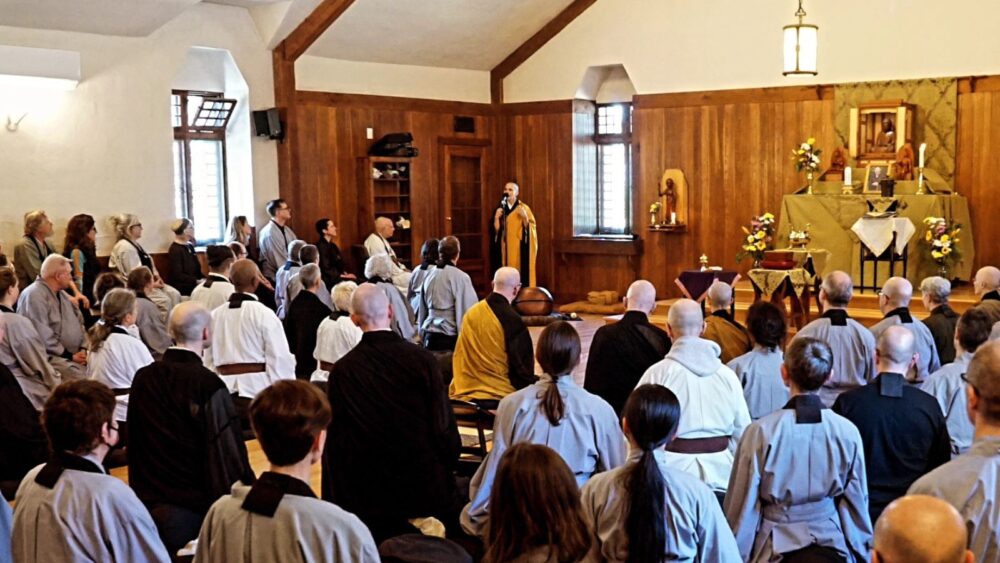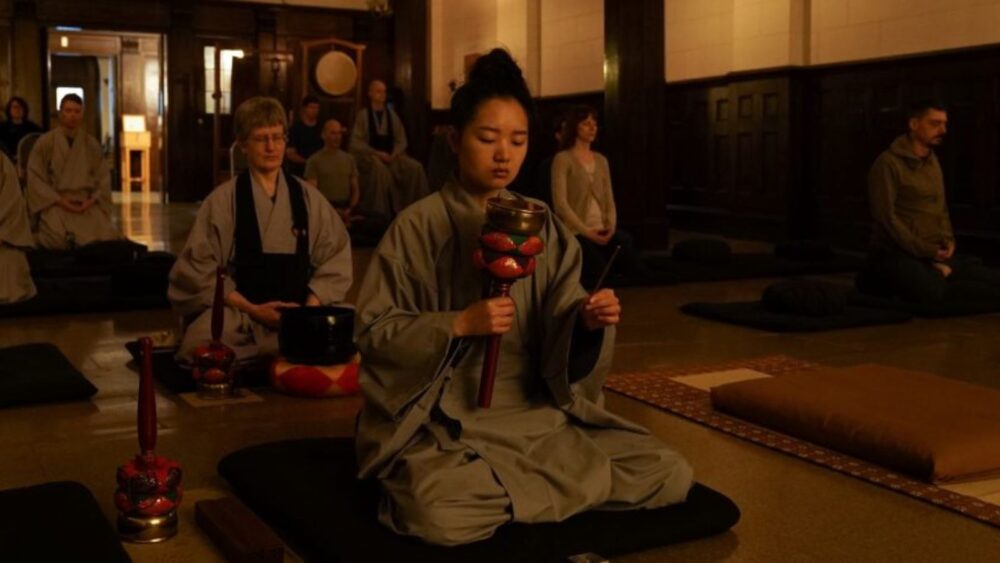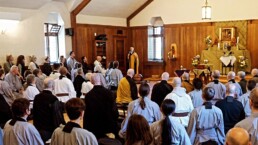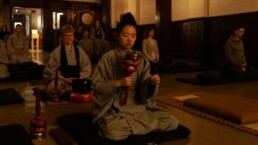Dharma Wisdom: Lessons From Zen Mountain Monastery

SHANDAKEN, N.Y. — On a recent Sunday morning at the Zen Mountain Monastery — nestled in the Catskill Mountains — more than a hundred worshippers gather for a service of chanting and meditation. Light floods through the windows of the lofted wooden room, illuminating the space. After two hours of chanting liturgy and sitting in Zazen meditation, the congregation stretches and shakes out their limbs before settling back down on their zabutons — cushioned mats. Some are crossed-legged, while others sit on their feet; all are turned towards the altar, prepared to receive the spiritual teaching known as the Dharma talk.
A man in a white robe — indicating his status as a senior student — walks down the aisle and approaches the altar. He performs a series of ritual bows, walks clockwise around his mat, and sits with his legs crossed. Then, a Buddhist priest walks down the aisle with a small lectern draped with a blue cloth and places it before him. The man unfolds the cloth to reveal a small notebook and reaches for a lavalier mic stowed beneath his mat. He clips the mic to his lapel, takes a deep breath, and presses his palms together, offering a gassho — a bow with hands in a prayer position — as an offering to the congregation and a sign that he's ready to begin his teaching.
A Buddhist priest in the corner of the room taps the rim of a large singing bowl three times, and the congregation begins to chant the names of the four bodhisattvas — enlightened beings who vowed to remain in the world to guide others, embodying central virtues such as compassion and wisdom that practitioners hope to cultivate.
In Buddhism, a Dharma talk is public discourse, given by a teacher or senior student, with the intention of providing practical wisdom about the practice. It is casual, with a conversational style, and has witticisms sprinkled throughout. It seems to balance the delight and discomfort of the practice perfectly, holding space for suffering while allowing joy to float to the surface.
On most Sundays at Zen Mountain, the Dharma talk is given by Sansho — the abbot of the Monastery — but he wasn't feeling well and asked Gikon — the man in the white robe — to fill in. Gikon opened by acknowledging his fear and anxiety, calling out his perfectionism and admitting that part of him didn't want to be giving this talk at all.
“The Buddhist teachings are often talked about like they're a raft,” Gikon said, “but for me, they are more like a life preserver.” He went on to give a testimony of his journey with the practice, starting with the first Buddhist teaching he read while in graduate school for social work. He learned that the ways we try to make sense of our lives are flawed. All of the great achievements that we value — philosophy, psychology, literature, art — take place just on the surface level of the mind and are therefore shallow pursuits. That was not what Gikon wanted to hear. At that point in his life, he had devoted himself to higher education — winning philosophy awards and studying the great poets. He had been in a desperate pursuit of something bigger, some undeniable truth that could give his life meaning. But when he read that first teaching, he realized there was something missing in his life and he turned to Buddhism.
The talk feels like a conversation. The congregation is deeply engaged, quick to laughter and hems and haws — vocal affirmations of a shared experience. Gikon speaks candidly about his fear and his daily struggle to go within. All the ways he used his mind to beat on his mind, in a failed attempt at mindfulness—or maybe control.
He encourages the congregation to sit with their fear, using it as a starting point to go deeper, through all their underlying assumptions, to the root of their suffering — the seed through which the fear was planted. Gikon credits the practice of Zazen — seated meditation — for changing his life and then presses his palms together, in one last gassho, indicating the end of his Dharma talk.
Rhythms of Reverence: Chanting and Meditation at Fire Lotus Temple

NEW YORK — On a recent Sunday morning, amid intermittent rain, worshippers leapt around growing puddles on the sidewalk outside Fire Lotus Temple in Brooklyn before entering through the large wooden doors. Located on the corner of Third Avenue and State Street in Park Slope, the temple’s aged brick facade and wooden placards stood out among the surrounding residential buildings. Upon entering the temple, the smell of incense greeted each visitor, inviting them into the sanctuary. One by one, people lined up in the vestibule, waiting to bow at the altar inside the temple to clear and purify their minds before crossing the threshold and entering the sacred space.
The sanctuary was a large room with low ceilings. There were 40 meditation mats, spaced out in even rows on the floor in front of the temple’s altar. Mara Leighton, a Brooklyn native dressed in navy sweats with her long brown hair thrown into a messy bun, entered the sanctuary minutes before the service began. She found a meditation cushion to her liking, and sat cross-legged, closing her eyes, taking a deep breath and settling into her mat.
After an opening procession and a series of bows, a Buddhist priest handed out liturgy books before taking a seat at the front of the room next to two large singing bowls. These bronze bowls—when gently struck or played with a mallet—produce rich, resonant tones that support the chanting by setting the rhythm and creating a meditative atmosphere. Everyone opened their books to page three, "The Heart Sutra." The priest scanned the room, waiting for everyone to settle before picking up a wooden mallet and slowly tracing the rim on the bowl three times. As the third ring started to fade, another priest made his way to a large bronze gong, or kesu, sitting in the back corner of the room. There was a brief pause, and then the priest struck the gong.
BONG.
The sound echoed through the sanctuary, and the head priest stood and chanted, “Maha Prajna Paramita Heart Sutra.” Then a third priest picked up a mallet and started banging a wooden drum carved like a fish holding a pearl in its mouth.
BOOM. BOOM. BOOM.
There was a moment of silence, and then the congregation joined in with “Avalokiteshvara Bodhisattva, doing deep Prajna Paramita,” spoken in traditional Sanskrit. The loud, rhythmic beats reverberated through the room. Even standing on thick mats, you still could feel the vibrations in your feet. Leighton stood, with her sock feet balancing half on her mat, glancing around the room, doing her best to pronounce the foreign lyrics. The chants got a little louder during the English verses, “Form is exactly emptiness, emptiness exactly form. Sensation, conception, discrimination, awareness are likewise like this.”
The Heart Sutra is the most popular sutra, or sacred teaching, in Mahāyāna Buddhism. Every morning, Buddhists around the world chant this sutra together as a reminder that form is an illusion. The Sutra goes through five skandhas, or the mental factors responsible for the rise of craving and clinging: form, sensations, perception, formations, and consciousness. The lyrics encourage Buddhists to release association with form to connect with a higher realm. But the chanting is not about the lyrics; it’s an invitation to allow the practice to carry them beyond wisdom, towards “wisdom beyond wisdom,” to a far shore of awakening that exists beyond suffering.
The resonant sounds filled the air, pulsing vibrations swirled through the sanctuary. Everyone chanted in unison, “Far beyond deluded thoughts; this is Nirvana.” As they chanted the final words of the Heart Sutra, translated as "Gone, gone, everyone gone to the other shore, awakening, svaha, the perfection of wisdom,” all the voices funneled together in a deep monotoned decrescendo, ending in abrupt silence.


